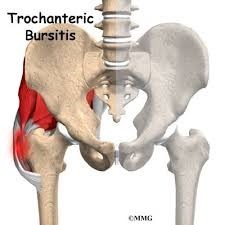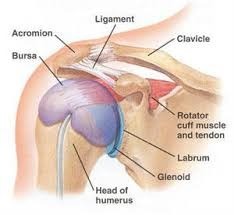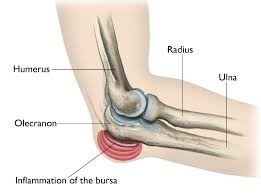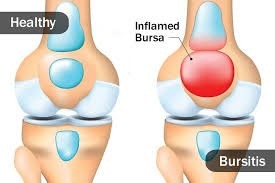What is bursitis?
Bursitis is the inflammation or irritation of the bursa. The bursa is a jelly-like sac filled with fluid, located between tissues such as bone, muscle, tendons, and skin that decreases rubbing friction and irritation. The human body has over 150 bursae; some are superficial and more vulnerable while others are deeper and better protected. Bursitis most commonly occurs in the knee, although it is known to also affect the elbow, shoulder, and hip joint.
What causes bursitis?
Repetitive bursa Irritation
Prolonged pressure or overuse of a certain joint, such as leaning on your elbow for long periods of time on hard surfaces, may cause the bursa to swell. Typically, this type of bursitis develops over several months and can be very painful. People in specific jobs are more vulnerable, particularly builders and plumbers who crawl on their knees in tight spaces and lean on their elbows. Certain athletic activities may also prompt the development of bursitis, such as long holds of the plank position and other repetitive exercises.
Traumatic Injury
You can develop bursitis from a direct injury such as a car accident or fall. The acute impact can cause an inflammatory healing reaction that results in swelling. Once the bursa is inflamed, normal movements and activities can become painful. If you fall and land on your knees, you can injure the prepatella bursa, causing bursitis.
Infection
It is fairly common for bursitis to become infected. Known as septic bursitis, this is a serious condition that will require immediate medical attention. This happens when bacteria enters the bursa through a cut or some other means. Usually the origin of the infection is unknown. Some of the symptoms include:
- Extreme warmth or redness to the area
- A high temperature
- Extreme tenderness
- Feeling very unwell
It can be difficult to tell the difference between bursitis and septic bursitis which is why you must seek medical attention as soon as possible to prevent the infection spreading to other parts of your body. Once the diagnosis has been made you will be given antibiotics.
Systemic diseases (rheumatoid arthritis, gout or diabetes)
Stress or inflammation from other medical conditions such as rheumatoid arthritis or gout can also increase your risk of developing bursitis. It is much more common in adults over 40 years of age and can affect many of your joints, including your shoulders, knees, elbows, hips, and ankles.
Types of bursitis
Trochanteric bursitis of the hip
This is inflammation of the bursa at the outside point of the hip, known as the greater trochanter. When this bursa becomes inflamed it can cause pain in the hip that can reduce your mobility and daily activities. Typically you will have pain on the outside of your hip, thigh, or in your buttock, as well as pain when laying on your hip in bed. This pain can worsen with simple daily activities such as rising up from a chair or getting in and out of a car.

You can get trochanteric bursitis from the following:
- An injury to your hip such as falling or bumping the hip into a hard object
- Work or sporting activities that overuse or cause injury to the hip, such as running upstairs, climbing, or standing for a long time
- Incorrect posture
- Stress of the soft tissues
- Other underlying medical issues such as rheumatoid arthritis, gout, psoriasis, and thyroid disease
- Previous surgery around the hip area
- Hip bone spurs
Subacromial bursitis of the shoulder
Subacromial bursitis is an intense pain in your shoulder that usually worsens when you elevate your arm. Early treatment for this condition can help prevent long-term problems.
Your shoulder is a common place for bursitis. The subacromial bursa in each shoulder helps your muscles and tendons (known as the rotator cuff) to function properly. Overuse of your shoulder muscle can cause damage and inflammation. You will have shoulder stiffness and pain which may even keep you awake at night as you cannot get comfortable. You may also notice swelling or redness and it can be very sore to touch.

Other factors that can cause this condition are:
- Age – bursitis in the shoulder becomes more common the older we get
- Poor posture
- Poor flexibility
- The shape of your shoulder bone can be a contributing factor
Olecranon bursitis
Elbow bursitis can occur when a fluid-filled sac located at the bony tip of the elbow becomes irritated or inflamed. Fluid will accumulate in the bursa and bursitis will develop. You will be aware of this condition as the first sign will be swelling and pain. When touching your elbow it may be red and warm. If this infection is not treated as soon as possible the infection may spread to other parts of your arm and into your bloodstream. Medical attention is needed as soon as possible.

Knee bursitis
This condition is caused by inflammation to the bursa in your knee joint. Any of the four bursae in your knee can become irritated and inflamed leading to pain and immobility. The symptoms that will show itself to you will vary from person to person depending on what is causing the inflammation. Your knee may feel warm to touch, tender, and/or swollen when you put pressure on it. Treatment for knee bursitis often includes physiotherapy and anti-inflammatory medications.

Causes of knee bursitis include:
- Frequent and sustained pressure such as kneeling for long periods of time on hard floors
- Overuse in certain activities
- A trauma to your knee
- A bacterial infection of the bursa
- Complications from rheumatoid arthritis or gout
- Being overweight
What are the early signs and symptoms of bursitis?
You may have bursitis if one of your joints is:
- Painful on movement
- Tender or warm
- Swollen or red
- Painful to touch
How is bursitis diagnosed?
After a full physical examination, your doctor will be able to diagnose bursitis based on your symptoms and pain levels. They may want some diagnostic testing to rule out other causes of your pain. These include:
- Xray
- Aspiration – in which fluid is taken from the bursa and evaluated in the lab
- Blood tests to screen for conditions such as rheumatoid arthritis or diabetes
- MRI scan (this is quite rare)
- Blood tests to rule out systemic causes of the bursitis
How is bursitis treated?
- Anti-inflammatory tablets to help reduce inflammation and pain
- Antibiotics
- Steroid injection
- Plasma Rich Protein (PRP) injection into the bursa
- Physiotherapy that includes stretching and strengthening exercises to improve any muscle imbalance and posture
- Avoiding activities that aggravate your flare-up
- Shockwave therapy
- Kinesio-taping to unload the bursa
- Surgery to drain or remove the bursa is considered a last resort if all other interventions fail
How physiotherapy can help your bursitis
We will do whatever we can to get you on the fastest route to recovery. Some of the treatment methods we use include:
- Mobilisation
- Strengthening exercises
- Myofascial trigger point release
- Pilates
- Cross-friction massage
- Stretching and range of movement exercises
- Acupuncture
- Functional exercises
- Kinesio-taping
